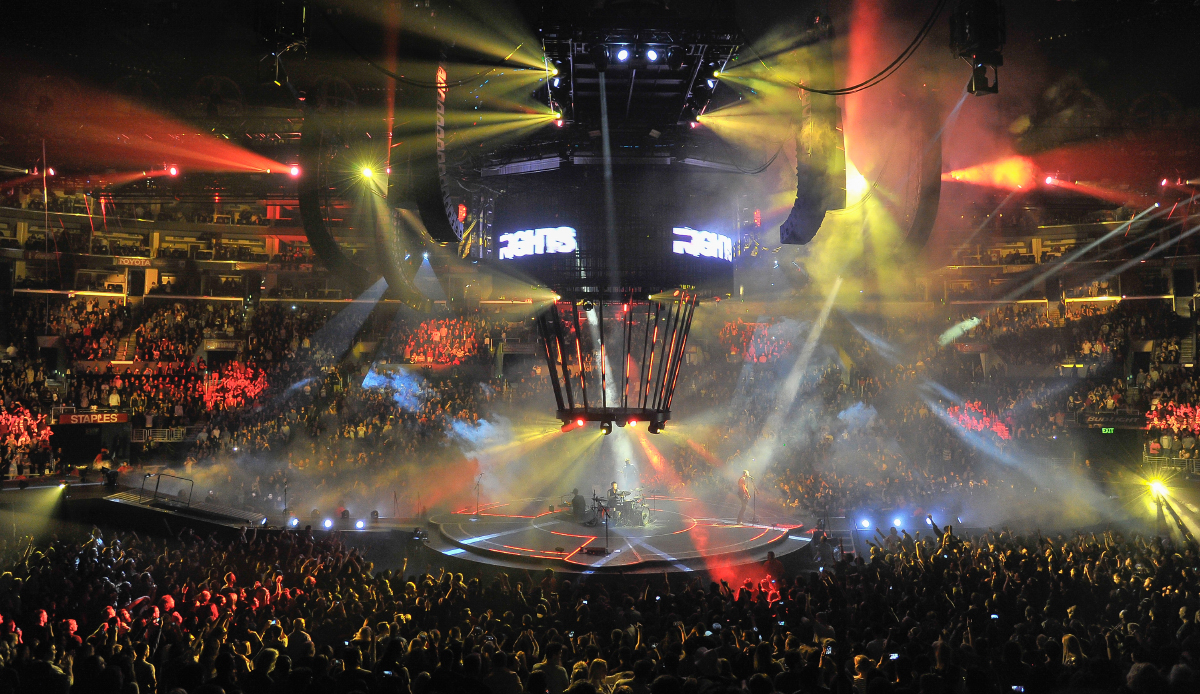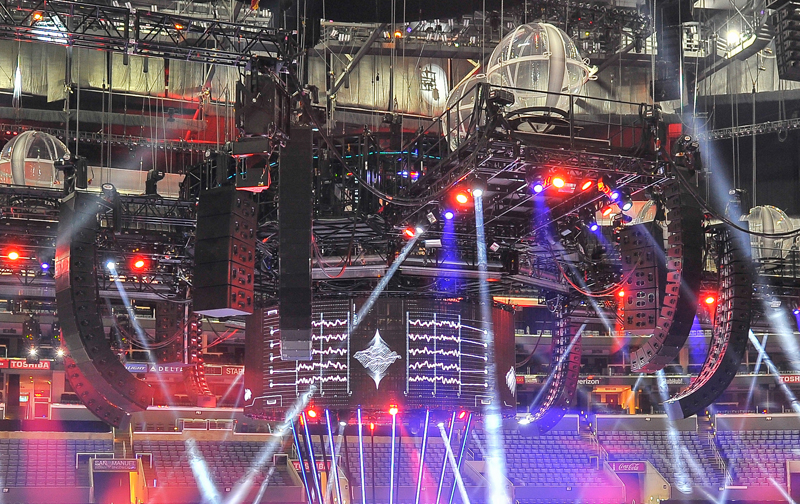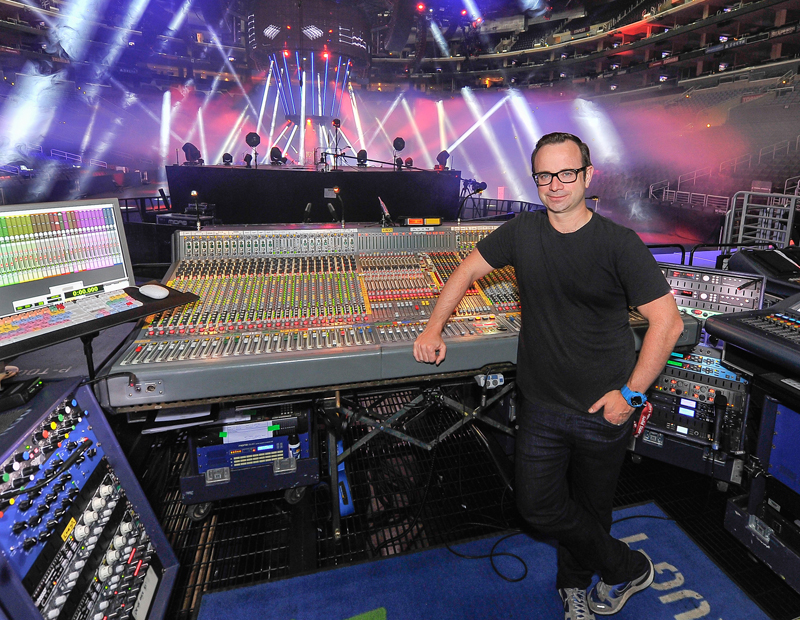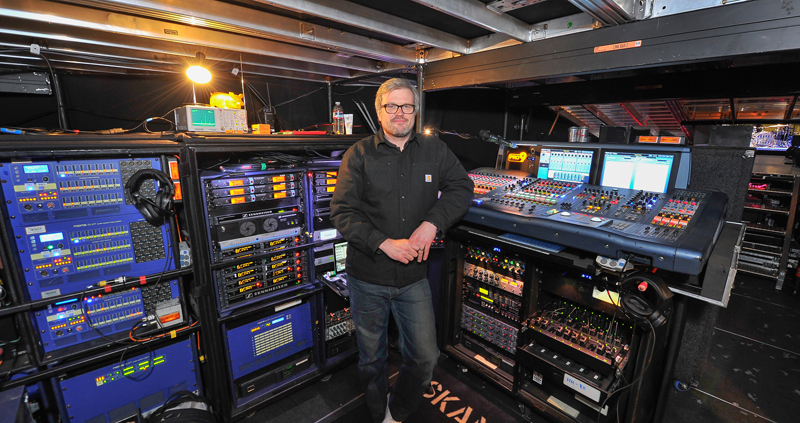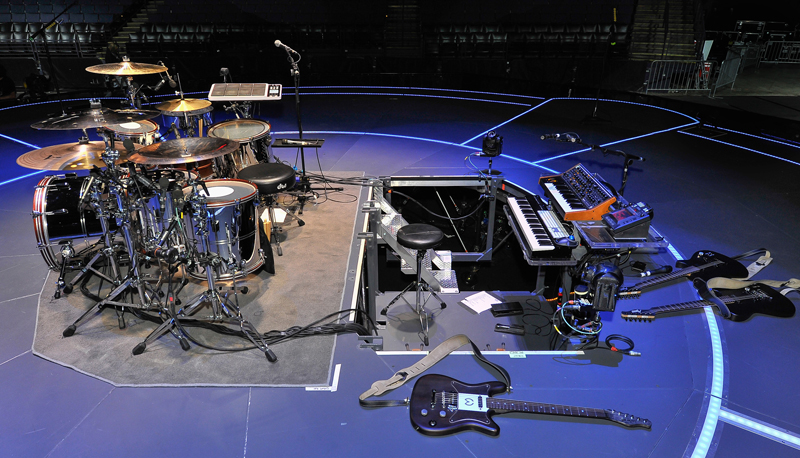Among the pantheon of arena rock legends, Muse just may be having a truly transcendent moment with its Drones World Tour, which kicked off in late November in Mexico City prior to settling in for the holidays with a pair of sold-out shows at the Staples Center in LA.
With early 2016 dates in Las Vegas, San Diego, Chicago, Montreal, and well beyond, the English rockers are bringing their brand of aural and visual spectacle to fans in the round from a 360-degree stage. Reinforced with a formidable audio cache assembled by Skan PA Hire Ltd., the show travels in 24 trucks and uses 32 hang points for the PA alone.
Ambitious by any measure, the show, according to Muse frontman Matt Bellamy, follows in the footsteps of Pink Floyd’s The Wall Tour. “It’s our version of ‘The Wall,’ basically,” he told BBC Radio 2. “There’s a whole swarm of drones, and a stage like a double-headed arrow.”
The drones of which Bellamy speaks are, for insurance purposes, referred to as Helium Flown Objects, or HFOs, by the production crew. Making their swarming presence felt from above at specific times during the show, they’re controlled by a networked tracking system. Narrow and low-slung, the stage creates an aura of intimacy in the arena spaces it was designed for.
Getting It Coordinated
To create the show’s sound reinforcement blueprint, Skan PA Hire’s Matt Vickers drew from an inventory of d&b audiotechnik components housed at Skan PA’s Newbury-based headquarters in the UK.
Flown within four separate zones, each of the PA quadrants comprises three independent hangs of its own employing d&b J-Series J8 cabinets, J-SUBs, and V-Series V8s. In total, there are 72 J8 enclosures and 72 V8 boxes that are flown, and 32 J-SUBs, some of which are flown and some of which are deployed under the stage along with eight J-INFRA Subs and four V-Series subs per side.
Power for the loudspeaker rig is provided in force via 84 d&b D80 amplifiers. System processing falls under the guidance of Lake controllers, which, along with the amps, are all housed come show time in a “space station” flown high above the crowd. Not merely a repository for gear, the space station is manned by crew members and engineers from the audio, video, rigging, and lighting teams, as well as HFO wranglers.
For audio crew chief Liam Tucker, the biggest challenge among many when assembling the PA in the round is that the stage can’t go in until everything flown is in place. “Because this show is in the round, the cables can only go in one way,” he says the day after the sold-out LA dates have successfully concluded. “So therefore if the lighting crew or anyone else runs into a problem above, the rig can’t go up, and then the stage can’t go in.
“With no stage we have no power to monitorworld or to start creating the PA network,” he continues. “No stage also means we have nothing to put the subs under, so we don’t have a full system to configure. The audio team is generally the last to be ready because we are so dependent upon everyone else being set to go.”
Joining Tucker on the audio crew are system tech Joachim Dewulf, front of house tech Eddie O’Brien, space station wingman/denizen Rob “Snowy” Wilkins, PA tech and support band coordinator Scott Maxwell, and wingman Matt Besford-Foster. Muse veterans Marc Carolan and Adam Taylor take charge of moving faders at front of house and monitors, respectively.
Developing A Process
An Irishman amidst a crew packing plenty of English presence, Carolan offers the chance for this American writer to further his understanding of English dialects as well as how to wring the most out of a Midas XL4 analog console.
“I’ve been using an XL4 on-and-off ever since I began mixing Muse 14 years ago,” Carolan tells me. “I love the preamps, plus it’s an ergonomic thing for me. I ran into a challenge this time because I can only address 127 scenes via MIDI with the XL4. I used those all up on the last tour, so this time I had to come up with a system that allowed me to automate and expand, but not rely on the XL4’s computer as much.”
His solution was to make good use of a Midas PRO2C sidecar, which is not really a sidecar in his scheme of things. But better to let him explain it himself: “The one thing Midas has done with all its digital kit is made the gain structure freakishly identical to their analog stuff. Therefore, in the past when I’ve used a PRO2 as a sidecar with my XL4, it felt just like an extension of the main board in terms of how I set up the gain structure. The interface and busing were just seamless.
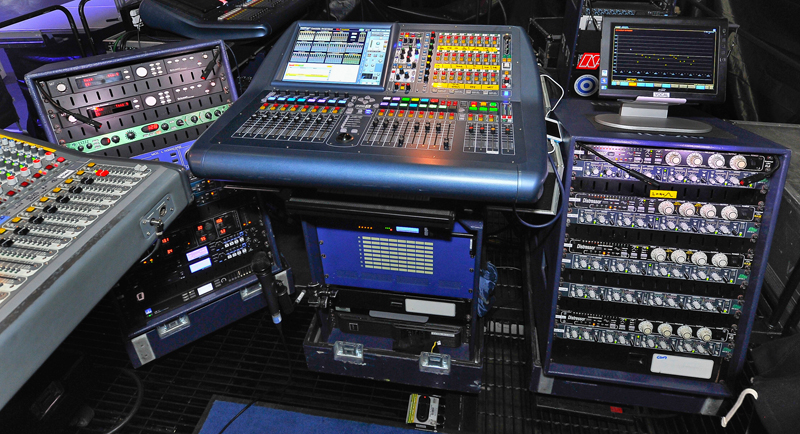
“Now I’m using half of a PRO2C’s resources to basically serve as automation for the XL4, and the net result of my efforts is that I’ve created an XL4 that’s as automated as a digital board. I can keep my hands on the faders and eyes on the band during the show, and all the automation simply happens in the background. I don’t ever have to think about it. If the purpose of any of these techno-complications we give ourselves is to simplify the mixing of the show, I think I’ve succeeded nicely.”
The Right Balance
Still standing with both feet firmly grounded in the analog world on this tour, Carolan naturally draws from an eclectic palette of outboard processing.
“A lot of this stuff is, well… it’s just classic,” he says, first noting his Bricasti M7 reverbs, which see use on vocals and toms.
Other recognized gold standards among his collection include a Line 6 Echo Pro delay modeler and Eventide H3000 harmonizer he calls upon for vocal effects, Yamaha SPX2000 added to snare and other percussion elements, and a dbx 120A subharmonic processor that gets sparingly splashed across the toms.
“I have a good palette to draw from,” Carolan continues. “But I like to think I use it tastefully, especially given the added amount of reflections and higher RT times we create playing in the round. Given our 360-degree configuration, the room comes into play a lot more in terms of trying to get even coverage. I’ve had to become very aware of managing the relationship between reflective and direct sound. The way I approach it is to get the system to do the work of balancing things. That way my mix can remain a mix, not a tool to reach sonic engineering goals.”
Part of the approach relies upon d&b audiotechnik’s ArrayProcessing functions, which are found within the ArrayCalc simulation software. Incorporating filter algorithms that calculate and optimize the performance of the d&b line arrays over the entire 360-degree area of coverage, it’s an ace in the hole in terms of achieving tonal balance.
“With ArrayProcessing,” he says, “I gain the peace of mind that the tonal and dynamic content of my mix is really spreading evenly across everyone’s ears. It makes a huge difference in this environment, where direct versus reflective sound is so important. I learned from the engineers at d&b that even the smallest tweaks can have maximum impact.
“Just a single dB often greatly alters whether what you perceive is in your face or heard outside of its spatial context. I can bias this system toward my needs of being linear in terms of power over distance, or linear in the sense of frequency response over distance. I have precise control over the amounts of energy present in the room, at all times and in all places.”
Heard, Not Seen
For his part, monitor engineer Adam Taylor deals with his mixes with an equal eye on every nuance. “Just like out front, being in the round makes my job difficult, as everyone is essentially in front of the PA all of the time,” Taylor points out. “There’s no hiding place ever.”
Just trying to find Taylor at a show is a dilemma in itself. Located not far from Carolan’s house position, he is nonetheless virtually invisible inside his bunker-like environment beneath the hammerhead of one of the thrusts, with little more than a letterbox to peer out of to physically see the stage. He mixes on a Midas PRO9, pushing the board hard with 79 inputs coming from the stage.
Keeping his stage volume down is imperative, so everyone is on wideband Sennheiser 2000 Series in-ear monitoring systems feeding either custom UE 11 buds from Ultimate Ears or generic Westone UM Pro 30s. Other than a lone bass amp, there isn’t a single traditional cabinet onstage, with guitars all using Kemper profiling systems instead.
Beyond the three core members of the band (frontman/multi-instrumentalist Matt Bellamy, bassist/backing vocalist Chris Wolstenholme, and drummer Dominic Howard), keyboardist/utility player Morgan Nicholls is on this tour. For the size and scope of this show, microphone inputs onstage are surprisingly spartan, with wireless Sennheiser transmitters sporting Neumann KMS 105 capsules being the choice for Bellamy and BETA 57A mics from Shure standing in for Wolstenholme’s backing vocals.
At drums, a beyerdynamic M88/Shure BETA 91 combination captures kick; there’s also a Shure SM57 on snare top, while hi-hat and ride cymbal get an AKG 451 and the overhead crash cymbals are individually miked with diminutive Neumann KM 184s.
“We’re struggling more than ever with spill,” Taylor notes. “Even though we have this massive stage, the band has actually wound up closer to the drums compared to gigs past, and then of course there’s the matter of playing in the round. All of our mic choices are calculated to help combat these problems while still providing the fidelity and performance the band requires.”
Making It So
Taylor’s mixes for the band are generally a bit of everything, with prominence given to each individual as needed by that person. While he is keen on the sound of the Midas PRO9 and its onboard dynamic EQ, he still uses some outboard gear to reach his mix goals. To that end a TC2000 and a Yamaha SPX1000 are MIDI-controlled and have a scene per song. With the TC unit managing longer delays and “bits of fancy stuff,” the SPX1000 makes itself heard on snare.
When Taylor calls up his scenes, he has four stereo mixes for each member of the band. From his outputs, signals travel through Aphex Dominator limiters along with a small amount of output EQ from the board for three of the mixes. For Bellamy’s mix, he uses a four-band GML Model 8200 parametric equalizer from George Massenburg Labs. Apart from that, the only other piece of outboard gear within his inventory is a Summit DCL-200 dual-channel tube compressor and limiter.
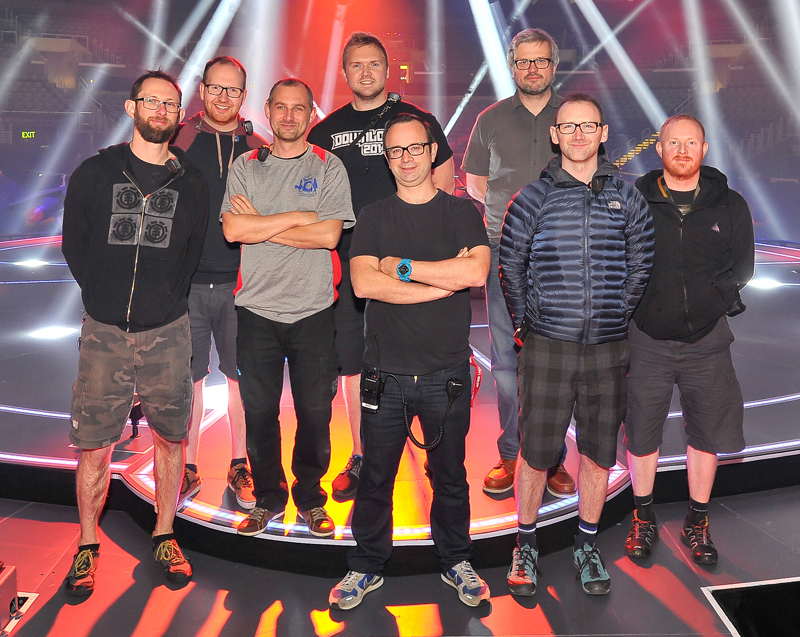
Sonically, the Drones World Tour finds the band and its production in top form and over the top, with an abundance of technology at its disposal that despite its multimedia madness, never descends into gimmickry.
“We’ve succeeded in turning something extremely difficult, expansive, and inert into something that is impressively musical and in motion,” crew chief Tucker says on a closing note. “There’s a mammoth amount of kit at large here, a mammoth amount of tech. To pull this show off every time is a big ask, but I guess we’ve proved it’s possible, wouldn’t you say?”

